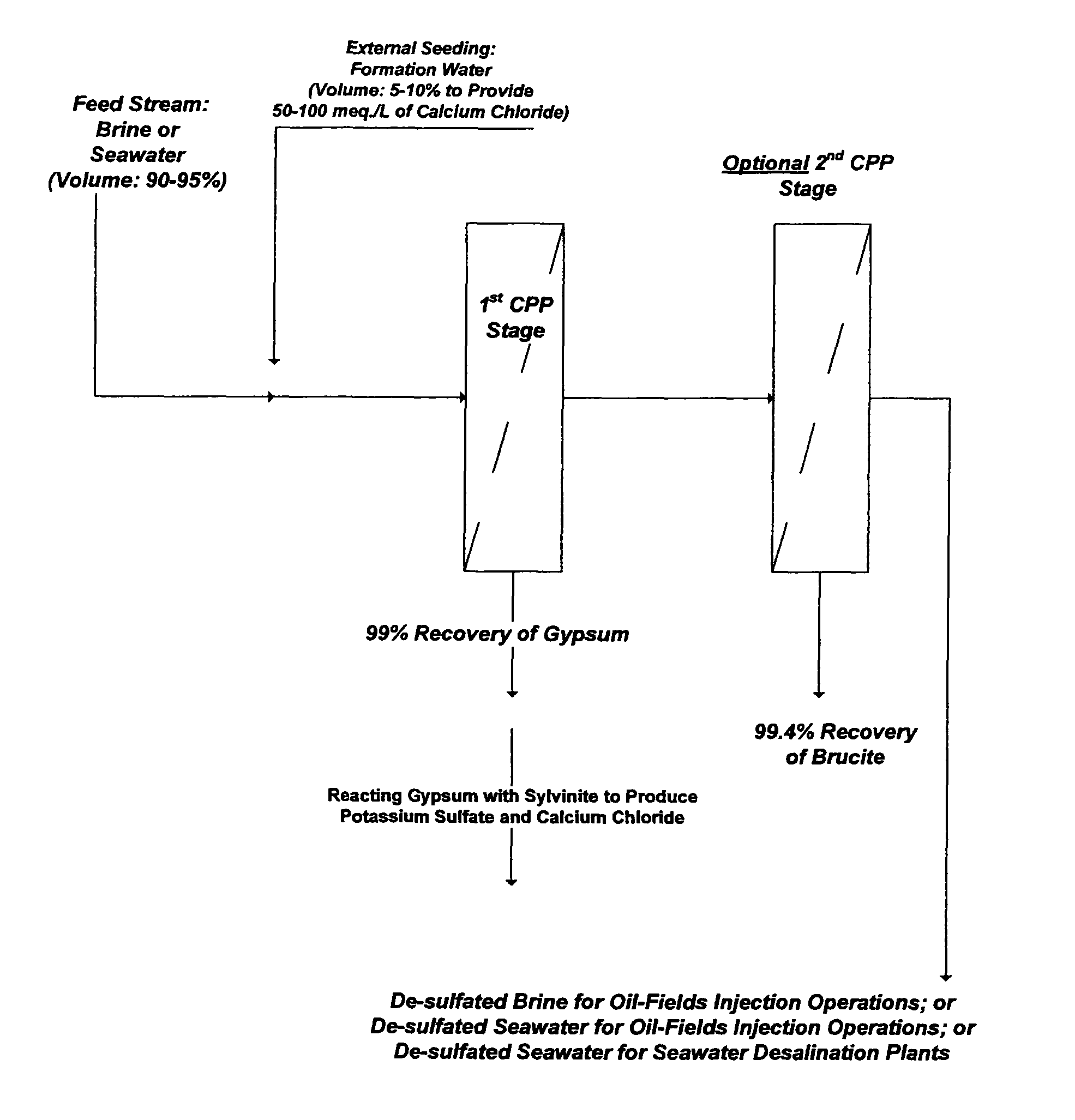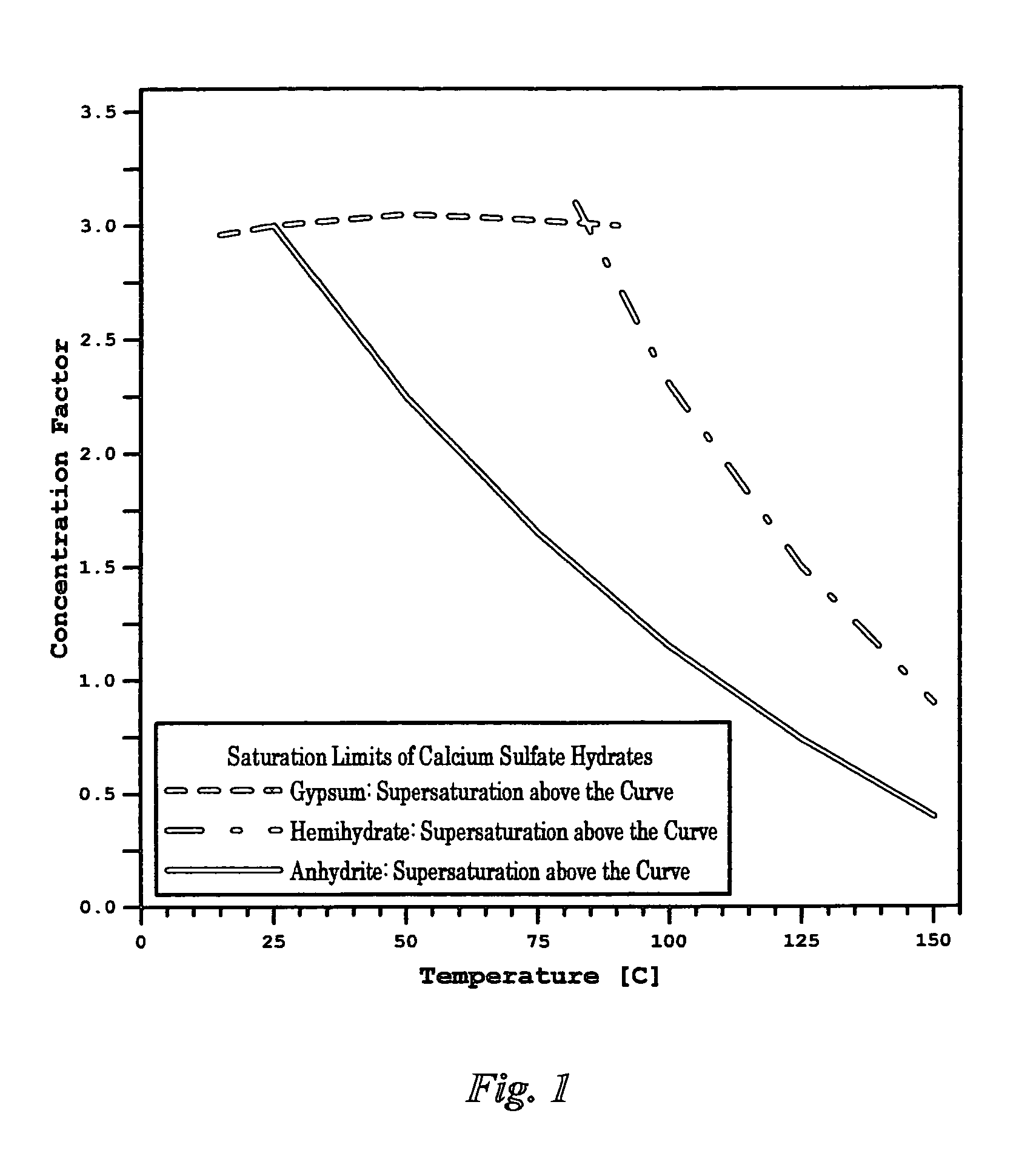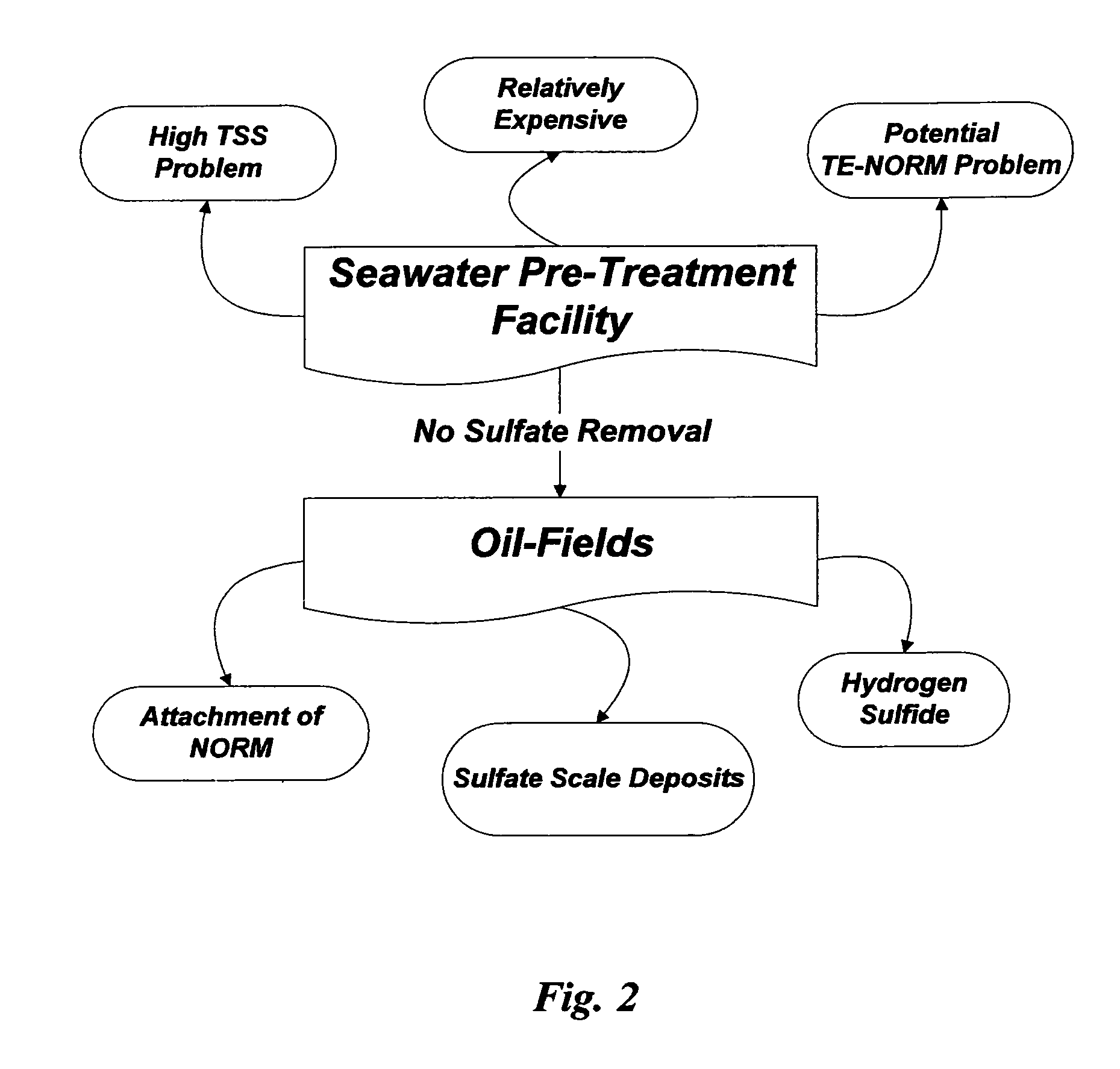Scale inhibitors, however, are primitive in nature with proven limited values in solving
sulfate scale problems, protecting
processing equipment, increasing overall recovery, and reducing
water production cost.
The
discharge of such brine streams into the sea could increase the
salinity around the intake lines of
seawater desalination systems, particularly when the dispersion of such streams is not fast enough (e.g., not enough natural current at the disposal site, relatively shallow water, and absence of mechanical dispersion devices).
In addition, the lack of
oxygen in such streams combined with higher
salinity, higher temperature, residues of deoxygenating chemicals (e.g.
sodium metabisulfate) and concentrated toxic species (e.g., derivatives of
boron and
chlorine) would adversely affect the marine environment.
Furthermore, the near induction
precipitation of
gypsum at the
discharge temperatures range (40-55° C.) in such streams would create a cloud of turbid precipitates once its discharged back to seawater (due to
salinity differences between seawater and the brine
stream) that poisons the marine
habitat.
As illustrated in FIG. 2, however, there are economical, technical and environmental problems associated within: (1) seawater pre-treatment facilities themselves; and (2) oil-fields that are subjected to seawater injection.
Problems within
Seawater Pre-Treatment Facilities
Such rough facilities are therefore expensive to operate in
spite of their apparent simplicity.
In addition, most if not all facilities are fitted with uncoated
carbon steel pipelines including the transfer pipeline to the targeted oil fields.
Such facilities are inherently flawed, and subsequently they are prone to: (1) contend with the coagulation-
filtration steps within the pre-treatment facility (improper location); and (2) regenerate an unacceptable high level of
total suspended solids (TSS) at the manifold of injection wells after the completion of seawater pre-treatment (uncoated transfer pipeline).
Within the operation of most seawater pre-treatment facilities, iron derivatives (
ferrous sulfate or
ferric sulfate or
ferric chloride) as coagulants, are also improperly utilized.
Their generated backwash-water has the highest solids load compared to other types of coagulants (
alum, ployelectrolytes, etc.) and is difficult to dewater (thickens poorly).
The problems with this “sweep floc” procedure include the: (1)
adverse effect on the permeability of the
filtration media contained within the filters, and thus more frequently filters backwash; (2) generation of excessive amounts of
sludge with high solids load (e.g.,
ferric hydroxide) in the backwash-
water recovery ponds; and (3) escape of a significant amount of the iron
ion from the filters to
effluent seawater, which with the aid of the
deoxygenation step (in the later stage) precipitates as
iron sulfide (raise the TSS again after the
filtration step).
Furthermore, operators tend to overdose the seawater feed
stream with
chlorine as a
biocide to kill organisms.
The combination of uncoated
carbon steel pipelines, the use of inappropriate coagulant, the overdose of
chlorine, the natural existence of small concentrations of the
uranium ion (5 μg / L) in seawater, along with the deoxygenating step will also introduce the problem of “Technologically Enhanced Naturally Occurring Radioactive Materials” (TE-NORM).
TE-NORM problems are increasingly becoming an
environmental issue, particularly in aging seawater pre-treatment facilities.
Ponds that hold blowdown water from cleaning pipelines of precipitating debris as well as the decommissioning of scraped pipelines represent radioactive hazards.
If the TSS reduction steps are cumbersome, then the consequence of injecting roughly pre-treated seawater with an unacceptable level of solids loading is costly.
The cost is not only in the direct form of operating a rough pre-treatment facility and adding a second filtration setup (after transferring pre-treated seawater via pipelines but before injection wells) but also in other substantial indirect forms within oil-fields such as injectivity decline and pore plugging, pumps degradation, and application of higher pressures that could possibly lead to the creation and growth of unwanted fractures.
Aside from the above discussed issues within strictly seawater pre-treatment facilities, the presence of sulfate in seawater causes enormous sulfate-related operational problems within oil-fields.
Sulfate scale deposits are hard, adherent, almost insoluble in mineral acids or other common solvents, and difficult to remove mechanically.
Hence, such deposits could cause severe flow restrictions within the drainage
radius inside the formation, within the
wellbore, and in
processing and surface equipment.
However, the accumulation of sulfate scale deposits within the invisible oil-bearing formation could cause the ultimate damage (permanent producing wells
shut down).
As the case with
seawater desalination plants, in
spite of a large number of proprietary chemical blends that are available as scale inhibitors and dissolvers, sulfate scale prevention or remediation with such chemicals has proved difficult, very expensive, and of limiting value for solving the scale problem or protecting reservoirs formation.
However, mechanical treatment is very expensive (e.g., wells shutdown, removal of rigs and
processing equipment, etc.) and limited to the removal of scale within the reachable range of processing equipment.
Therefore, the shared
disadvantage of both chemical and mechanical treatment is the inability to mitigate any downhole formation damages.
Most, if not all, oil producers do not properly document the exact cost of sulfate scale remedial workovers.
Radium and its isotopes tend to co-precipitate with other sparingly soluble alkaline cations in the forms of sulfate, and thus oil-fields
produced water could become radioactive.
As such, external (near any processing equipment), and internal (during maintenance or workovers) radioactive hazards could exist due to NORM adherent to sulfate scale during processing.
Direct costs of NORM inspection and disposal include
radionuclide analysis, actual disposal operation, transportation, storage and equipment decontamination.
Long-term liability is an additional cost.
Hydrogen sulfide is also lethal at levels above 1000 mg / L for exposures over two minutes, and therefore, installations of worker-health safeguards monitoring systems are required.
However, there is a persistent tendency within oil producers to use available water for injection operations, regardless of the fact that sulfate scale will cause critical problems, and then attempting to remedy such problems that are deliberately allowed to occur.
Short-term solutions often become long-term lingering problems.
 Login to View More
Login to View More  Login to View More
Login to View More 


